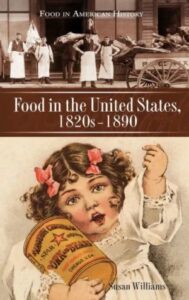 One of my favorite mantras is “there’s so much history we can learn through food.” Pick any era, and you can delve into a variety of culinary-related subjects that aid in our understanding of history. For example: what people ate (and what they didn’t eat), what was trendy, what food was available (and what wasn’t), what were acceptable (and accessible) cooking methods, who was doing the cooking, what types of cooking utensils were used, etc. The list goes on.
One of my favorite mantras is “there’s so much history we can learn through food.” Pick any era, and you can delve into a variety of culinary-related subjects that aid in our understanding of history. For example: what people ate (and what they didn’t eat), what was trendy, what food was available (and what wasn’t), what were acceptable (and accessible) cooking methods, who was doing the cooking, what types of cooking utensils were used, etc. The list goes on.
As I have written about previously, one of the best ways to do this is to go through both historical and manuscript cookbooks. Not only can you see what was popular at the time, but you can get a sense of food and cooking evolution, as techniques and ingredients change over time. As a food writer, it is fun to do this hands-on research and make my own inferences and observations.
But it is also imperative and important to see what other culinary experts and historians have written on various topics. It provides a point of reference and validity to my assumptions. As a result, I have several ear-worn books that I have referred to over and over, such as Food in the United States: 1820s-1890 and Savory Suppers and Fashionable Feasts, (Library Journal review here) both by Susan Williams. Both contain a treasure-trove of recipes, foods, cooking utensils and methods, serving dishes and exactly what was “in vogue” in the nineteenth century. The Oxford Companion to American Food and Drink, edited by renowned food historian Andrew F. Smith, is another of my food “bibles.” You don’t even want to see the condition of my copy at this point!

I am also always on the lookout for new books on related topics. As with any research, new discoveries are made, and viewpoints and philosophies change. One of my favorite books of late is The Ark of Taste: Delicious and Distinctive Foods That Define the United States by David Shields (Library Journal review here). This delightful book has beautifully illustrated pages chronicling heritage foods and what the Slow Food USA movement is doing to help preserve them. I am thrilled that Dr. Shields will be presenting to The Historic Foodways Society of the Delaware Valley (of which I am a member) tomorrow, March 21. I can’t wait to hear what he has to say! Other recent “finds” include The Secret History of Food by Matt Siegel and Eating to Extinction by Dan Saladino, both chronicled in my previous post, Food Behind the Scenes.
There are several books on culinary history at Rutgers, including a few that go back to the nineteenth century, such as:
- A treatise on adulterations of food and culinary poisons (1820) by Friedrich Christian Accum
- The pantropheon: or, History of food and its preparation: from the earliest ages of the world (1853) by Alexis Soyer (the illustrious French chef, writer and inventor who made his reputation in Victorian England)

And others from more recent decades:
- Consumption, Food and Taste: Culinary Antinomies and Commodity Culture (1997) by Alan Warde (Exploring the expression of taste through the processes of consumption)
- Revolution at the Table: The Transformation of the American Diet (1998 and 2003) by Harvey A. Levenstein (an exhaustive and entertaining chronicle of what Americans ate from 1880 to 1930)
- An archive of taste: race and eating in the early United States (2020) by Lauren F. Klein (The first book to examine the gustatory origins of aesthetic taste in early American literature, showing how thinking about eating can help to tell new stories about the range of people who worked to establish a cultural foundation for the United States)